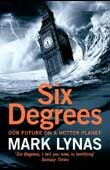‘Six Degrees: Our Future on a Hotter Planet’ by Mark Lynas
Posted in Books on 01/02/2010 07:27 pm by Stephen Tindale Six Degrees won the UK Royal Society Science Books Prize in 2008. It’s extremely well written and readable but, because it is an illustration of the effects that different temperature increases will have, it is not exactly cheerful. Yet, anyone interested in climate change – or indeed human survival – should read it, to understand the worst-case scenario, against which other alternatives must be judged. The Royal Society describes the book as follows:
Six Degrees won the UK Royal Society Science Books Prize in 2008. It’s extremely well written and readable but, because it is an illustration of the effects that different temperature increases will have, it is not exactly cheerful. Yet, anyone interested in climate change – or indeed human survival – should read it, to understand the worst-case scenario, against which other alternatives must be judged. The Royal Society describes the book as follows:
“Mark Lynas’s incredible new book is not science-fiction; nor is it sensationalist. The six degrees of the title refer to the terrifying possibility that average temperatures will rise by up to six degrees within the next hundred years. This is the first time we have had a reliable picture of how the collapse of our civilisation will unfold unless urgent action is taken. Most vitally, Lynas’s book serves to highlight the fact that the world of 2100 doesn’t have to be one of horror and chaos. With a little foresight, some intelligent strategic planning, and a reasonable dose of good luck, we can at least halt the catastrophic trend into which we have fallen. But the time to act is now.”
(See The Royal Society: Six Degrees: Our Future on a Hotter Planet.)
Below is an article by Mark, published in The Guardian newspaper in April 2009 and on his own website (see marklynas.org: Climate change explained: the impact of temperature rises), and reproduced here with his permission. He describes it as “a slightly updated précis of Six Degrees”.
Climate change explained: the impact of temperature rises.
Less than 2C
Arctic sea icecap disappears, leaving polar bears homeless and changing the Earth’s energy balance dramatically as reflective ice is replaced during summer months by darker sea surface. Now expected by 2030 or even earlier.
Tropical coral reefs suffer severe and repeated bleaching episodes due to hotter ocean waters, killing off most coral and delivering a hammer blow to marine biodiversity.
Droughts spread through the sub-tropics, accompanied by heatwaves and intense wildfires. Worst-hit are the Mediterranean, the south-west United States, southern Africa and Australia.
2C-3C
Summer heatwaves such as that in Europe in 2003, which killed 30,000 people, become annual events. Extreme heat sees temperatures reaching the low 40s Celsius in southern England.
Amazon rainforest crosses a “tipping point” where extreme heat and lower rainfall makes the forest unviable – much of it burns and is replaced by desert and savannah.
Dissolved CO2 turns the oceans increasingly acidic, destroying remaining coral reefs and wiping out many species of plankton which are the basis of the marine food chain. Several metres of sea level rise is now inevitable as the Greenland ice sheet disappears.
3C-4C
Glacier and snow-melt in the world’s mountain chains depletes freshwater flows to downstream cities and agricultural land. Most affected are California, Peru, Pakistan and China. Global food production is under threat as key breadbaskets in Europe, Asia and the United States suffer drought, and heatwaves outstrip the tolerance of crops.
The Gulf Stream current declines significantly. Cooling in Europe is unlikely due to global warming, but oceanic changes alter weather patterns and lead to higher than average sea level rise in the eastern US and UK.
4C-5C
Another tipping point sees massive amounts of methane – a potent greenhouse gas – released by melting Siberian permafrost, further boosting global warming. Much human habitation in southern Europe, North Africa, the Middle East and other sub-tropical areas is rendered unviable due to excessive heat and drought. The focus of civilisation moves towards the poles, where temperatures remain cool enough for crops, and rainfall – albeit with severe floods – persists. All sea ice is gone from both poles; mountain glaciers are gone from the Andes, Alps and Rockies.
5C-6C
Global average temperatures are now hotter than for 50m years. The Arctic region sees temperatures rise much higher than average – up to 20oC – meaning the entire Arctic is now ice-free all year round. Most of the topics, sub-tropics and even lower mid-latitudes are too hot to be inhabitable. Sea level rise is now sufficiently rapid that coastal cities across the world are largely abandoned.
6C and above
Danger of “runaway warming”, perhaps spurred by release of oceanic methane hydrates. Could the surface of the Earth become like Venus, entirely uninhabitable? Most sea life is dead. Human refuges now confined entirely to highland areas and the polar regions. Human population is drastically reduced. Perhaps 90% of species become extinct, rivalling the worst mass extinctions in the Earth’s 4.5 billion-year history.
Mark Lynas is an activist, journalist and traveller. He was editor of the website https://uk.oneworld.net/ and has made many appearances in the press and TV as a commentator on environmental issues.



